
A samosa or sambosa is a fried South Asian pastry with a savoury filling, including ingredients such as spiced potatoes, onions, peas, meat or fish. It may take different forms, including triangular, cone, or half-moon shapes, depending on the region. Samosas are often accompanied by chutney, and have origins in medieval times or earlier. Sweet versions are also made. Samosas are a popular entrée, appetizer, or snack in the cuisines of South Asia, the Middle East, Central Asia, East Africa and their South Asian diasporas.

Pakora is a fritter originating from the Indian subcontinent. They are sold by street vendors and served in restaurants in South Asia. It consists of items, often vegetables such as potatoes and onions, coated in seasoned gram flour batter and deep fried.

Upma, uppumavu, or uppittu is a dish originating from the Indian subcontinent, most common in Kerala, Andhra Pradesh, Tamil Nadu, Telangana, Karnataka, Maharashtrian, and Sri Lankan Tamil breakfast, cooked as a thick porridge from dry-roasted semolina or coarse rice flour. Various seasonings and/ vegetables are often added during the cooking, depending on individual preferences.

Bombay mix or Chanachur is an Indian snack mix (namkeen) which consists of a variable mixture of spicy dried ingredients, such as fried lentils, peanuts, chickpeas, chickpea flour ganthiya, corn, vegetable oil, puffed rice, fried onion and curry leaves. This is all flavored with salt and a blend of spices that may include coriander and mustard seeds.

Chaat, or chāt is a family of savoury snacks that originated in India, typically served as an hors d'oeuvre or at roadside tracks from stalls or food carts across South Asia in India, Pakistan, Nepal and Bangladesh. With its origins in Uttar Pradesh, India, chaat has become immensely popular in the rest of South Asia.

Cuisine of the Indian subcontinent includes the cuisines from the Indian subcontinent comprising the traditional cuisines from Bangladesh, Bhutan, India, the Maldives, Nepal, Pakistan and Sri Lanka.

Kachori is a sweet and spicy deep-fried snack, originating in India subcontinent, and common in places with Indian diaspora and other South Asian diaspora. Alternative names for the snack include kachauri, kachodi and katchuri.
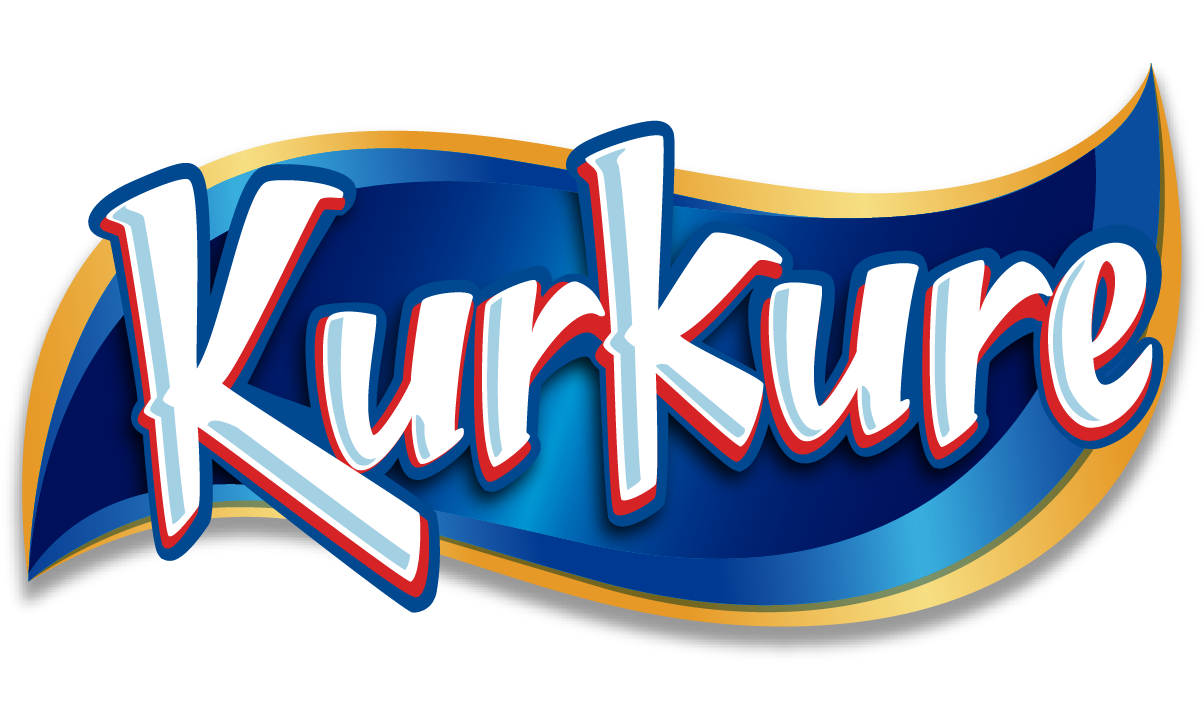
Kurkure is a brand of spiced crunchy puffcorn snacks made up of rice, lentil and corn, owned by PepsiCo. It was launched in 1999 in India. The snack is currently being manufactured and sold in India, Pakistan and Bangladesh. The snack has limited availability in certain international markets such as Canada and the United Kingdom.
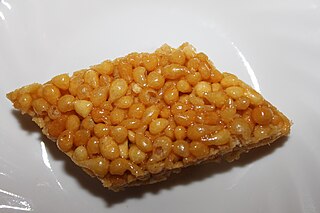
Boondi is an Indian snack made from fried chickpea flour, either as a savory snack or sweetened as a dessert.
Bihari cuisine is eaten mainly in the eastern Indian state of Bihar, as well as in the places where people originating from the state of Bihar have settled: Jharkhand, Eastern Uttar Pradesh, Bangladesh, Nepal, Mauritius, South Africa, Fiji, some cities of Pakistan, Guyana, Trinidad and Tobago, Suriname, Jamaica, and the Caribbean. Bihari cuisine includes Bhojpuri cuisine, Maithil cuisine and Magahi cuisine.
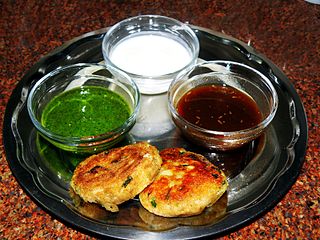
Aloo tikki, also known as aloo ki tikkia, aloo ki tikki or alu tikki, is a snack originating from the Indian subcontinent. In Indian, Pakistani, and Bangladeshi preparation, it is made of boiled potatoes, peas, and various curry spices. Aloo means potato in Hindi-Urdu, and tikki is a small cutlet or croquette. The dish is served hot along with a side of saunth, tamarind, and coriander-mint sauce, and sometimes dahi (yogurt) or chickpeas.
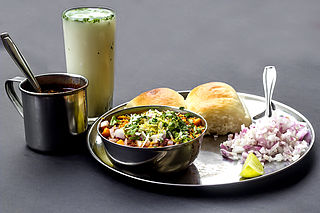
Misal pav is a dish from the Indian state of Maharashtra. It consists of misal and pav. The final dish is topped with farsan or sev, onions, lemon and coriander (cilantro). It is usually served hot with bread or rolls toasted with butter and buttermilk or dahi and papad. It is served as a breakfast dish, as a snack and also as a full meal.

Malaysian Indian cuisine, or the cooking of the ethnic Indian communities in Malaysia, consists of adaptations of authentic dishes from India, as well as original creations inspired by the diverse food culture of Malaysia. Because the vast majority of Malaysia's Indian community are of South Indian descent, and are mostly ethnic Tamils who are descendants of immigrants from a historical region which consists of the modern Indian state of Tamil Nadu and Sri Lanka's Northern Province, much of Malaysian Indian cuisine is predominantly South Indian inspired in character and taste. A typical Malaysian Indian dish is likely to be redolent with curry leaves, whole and powdered spice, and contains fresh coconut in various forms. Ghee is still widely used for cooking, although vegetable oils and refined palm oils are now commonplace in home kitchens. Before a meal it is customary to wash hands as cutlery is often not used while eating, with the exception of a serving spoon for each respective dish.

Alu chat is a street food originating from the Indian subcontinent, it is popular in North India, West Bengal in Eastern India, Pakistan, parts of Sylhet Division of Bangladesh and Trinidad and Tobago. It is prepared by frying potatoes in oil and adding spices and chutney. It can also be prepared with unfried boiled potatoes and also adding fruits along with spices, lime juice and chutney.

Vada is a category of savoury fried snacks native to South India. Vadas can be described variously as fritters, cutlets, or dumplings. Alternative names for this food include vadai, vade, and bada. Vadas are sometimes stuffed with vegetables and traditionally served with chutneys and sambar.
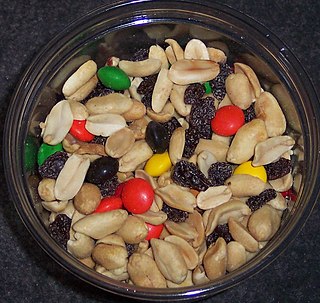
A snack is a small portion of food generally eaten between meals. Snacks come in a variety of forms including packaged snack foods and other processed foods, as well as items made from fresh ingredients at home.
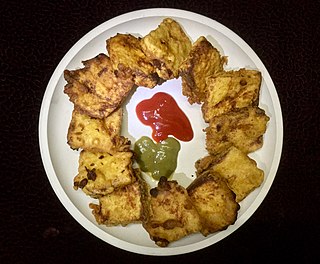
Bread pakora is an Indian and Pakistani fried snack. It is also known as bread bhaji. A common street food, it is made from bread slices, gram flour, and spices among other ingredients.
















